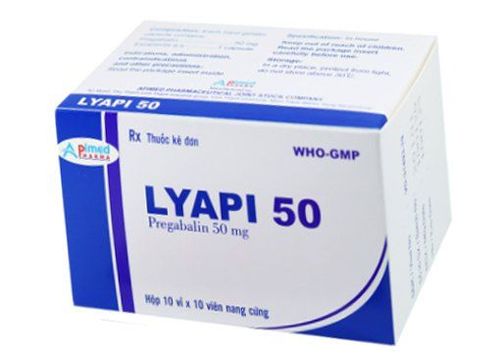This is an automatically translated article.
Craba belongs to the group of psychotropic drugs used to treat neuropathic pain of central or peripheral origin, adult anxiety disorder and partial seizures. The drug is prepared in the form of hard capsules with 2 strengths of 75mg and 150mg. The following article will provide you with information about the uses, indications, dosage and possible side effects when using Craba.
1. Uses of Craba
What is Craba drug? Craba 75mg and 150mg pills have Pregabalin as the main ingredient. Pregabalin is structurally similar to GABA, a chemical mediator with CNS depressant effects. However, unlike other CNS depressants, Pregabalin does not bind directly to GABA-A, GABA-B or benzodiazepine receptors. Thus, Pregabalin did not increase the response and did not alter the concentration of GABAA in the experimentally cultured neurons. According to research, long-term use of Pregabalin will increase the rate of GABA transport and the density of transport proteins.
Pregabalin binds to CNS tissues at the α -δ site with high affinity. Although the exact mechanism is unknown, binding to the α-δ subunit may be involved in pregabalin's analgesic and anticonvulsant effects.
Craba medicine 75mg and 150mg is indicated in the following cases:
Nerve pain of central origin Neuropathic pain of peripheral origin such as pain due to fibromyalgia, pain due to diabetes or postherpetic neuralgia Disorders Generalized anxiety disorder in adults Adjunctive treatment of partial seizures with or without generalized seizures Do not use Craba in people with a history of allergy to any of the ingredients. To ensure safety during treatment with Craba 75mg or 150mg, patients need to inform their doctor about their allergy history and medical condition so that they can consider using the drug.
2. Dosage and how to use Craba
The drug Craba is taken orally. Patients taking Craba tablets whole with water, do not crush or chew as this may reduce the absorption of the drug. Craba 75mg and 150mg can be taken before or after meals.
Usual dose: 150-600 mg/day, divided into 2 or 3 times In case of pain of nerve origin:
Initial dose: 150 mg/day in 2 or 3 divided doses After 3-7 days, may increase up to 300 mg/day based on patient response and tolerability. May increase to a maximum dose of 600 mg/day for the next 7 days. In case of generalized anxiety disorder in adults:
Initial dose: 150 mg/day After 7 days may increase to 300 mg/day, up to 450 mg or 600 mg/day for the next 7 days depending on Patient response and tolerance Epilepsy:
Initial dose: 150 mg/day in 2 or 3 divided doses May be increased to 300 mg/day after 1 week, and increased to a maximum dose of 600 mg /day for the next 1 week. The above is the recommended dosage for general cases. To know the right dose and time to take the drug, patients need to consult their doctor to know more. When discontinuing the use of Craba 75 mg and 150 mg, the dose must be gradually reduced for at least 1 week, not abrupt discontinuation will occur undesirable side effects such as withdrawal syndrome.
3. Side effects of the drug Craba
Some patients may experience unwanted side effects when taking Craba such as:
Stimulate the appetite, which can lead to binge eating. Drowsiness, dizziness, or vestibular disorders Decreased ability to regulate behavior, activity, or coordination of movements Excitement, headache, trouble sleeping, increased excitement Decreased vision or double vision Erectile dysfunction , decreased sex drive Fatigue, peripheral edema, edema Causing a feeling of intoxication The patient needs to stop taking the drug and go to the nearest medical facility for appropriate treatment when experiencing the above symptoms during the procedure. Use Craba.
4. Notes when using the drug Craba
Caution when using Craba drug in people with medical conditions such as: kidney failure, cardiovascular disease, diabetes, brain diseases or the elderly Caution when using Craba drug in subjects under 18 years of age because of its effectiveness Results and safety have not been verified. Need to stop taking the drug immediately and go to the nearest medical facility if symptoms of angioedema appear when using Craba 75mg or 150mg Do not stop taking Craba suddenly because it will cause side effects heavier. Patients need the guidance of the doctor to reduce the dose slowly at least 1 week. It is necessary to strictly control the course of treatment with Craba in patients, to prevent cases of subjects with drug abuse or suicidal thoughts with drugs. Craba 150mg or 75mg can cause visual impairment. Patients should have their vision checked regularly while taking the drug. Craba can cause drowsiness, headache, lethargy, should not be used when the patient must perform activities such as driving or operating machinery. Craba should not be used during pregnancy, unless the benefits outweigh the risks and there are no other alternatives. Breastfeeding women should not be treated with Craba 150mg or 75mg because the drug can be excreted in breast milk and affect the baby.
5.Crab drug interactions
Craba drug can interact if used concurrently with the following drugs:
Lorazepam: impaired cognitive and motor abilities Alcohol: increases the effect of alcohol, causing headaches, dizziness, drowsiness Antidiabetic drugs Thiazolidinediones, CNS depressants, selective serotonin reuptake inhibitors: Craba may increase the concentration or effects of these drugs. Methotrimeprazine, Hydroxyzin or Droperidol: increase the concentration of Craba in the blood. Ketorolac, Mefloquin: reduce the concentration of Pregabalin in the blood The above is all information about the drug Craba, patients need to carefully read the instructions for use, consult a doctor and must strictly follow the indications to use the drug. effective, reducing unwanted side effects.
Please dial HOTLINE for more information or register for an appointment HERE. Download MyVinmec app to make appointments faster and to manage your bookings easily.













